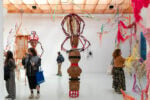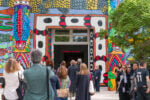Anche le sculture muoiono
.jpg)
Per la primavera 2015 Il Centro di Cultura Contemporanea Strozzina di Palazzo Strozzi propone una nuova programmazione espositiva che ha inizio con la mostra collettiva Anche le sculture muoiono, a cura di Lorenzo Benedetti, che presenta una riflessione sulla scultura contemporanea.
Comunicato stampa
Dal 17 aprile al 26 luglio 2015 gli spazi del Centro di Cultura Contemporanea Strozzina di Palazzo Strozzi ospiteranno la mostra collettiva Anche le sculture muoiono (17 aprile-26 luglio 2015), a cura di Lorenzo Benedetti, che presenta una riflessione sul significato, le possibilità e le nuove sperimantazioni della scultura contemporanea, attraverso le opere e nuove produzioni di tredici artisti italiani e internazionali come: Francesco Arena (Italia), Nina Beier (Danimarca), Katinka Bock (Germania), Giorgio Andreotta Calò (Italia), Dario D'Aronco (Italia), N.Dash (USA), Michael Dean (Regno Unito), Oliver Laric (Austria), Mark Manders (Olanda), Michael E. Smith (USA), Fernando Sánchez Castillo (Spagna), Francisco Tropa (Portogallo), Oscar Tuazon (USA)
Gli artisti contemporanei utilizzano nuove forme e materiali investendo su una condizione temporale più ampia, in un dialogo tra passato e futuro. Allo stesso tempo, tuttavia, la mostra riflette su come gli artisti di oggi riscoprano materiali quali il bronzo, la pietra o la ceramica, che sembravano essere relegati alla pura accademia. Questi materiali sono ripresi e utilizzati in forma concettuale per riflettere su temi come quello del monumento, del frammento, del consumo della materia o sul recupero del recente passato modernista.
L’esposizione si terrà in concomitanza con la mostra di Palazzo Strozzi Potere e pathos. Bronzi del mondo ellenistico (14 marzo-21 giugno 2015) organizzata in collaborazione con il J. Paul Getty Museum di Los Angeles e la National Gallery of Art di Washington, che illustra, attraverso l’esposizione di eccezionali esempi di sculture bronzee di grandi dimensioni, lo sviluppo dell’arte nell’Età Ellenistica fra il IV ed il I secolo a.C.
La presenza di queste due mostre creerà a Palazzo Strozzi una straordinaria occasione di dialogo e confronto tra antico e contemporaneo. La scultura del passato ci è pervenuta soprattutto grazie alla sua capacità di sopravvivere nel tempo, in alcuni casi solo come frammento, mentre la percezione oggi di queste opere si divide tra una dimensione di durevolezza e una di effimerità e trasformazione del proprio valore e della propria connotazione originaria.
Come sottolinea il curatore Lorenzo Benedetti, la mostra del CCC Strozzina permette di andare oltre una mera contrapposizione tra passato e presente andando a individuare aspetti centrali della scultura contemporanea nella sua contrapposizione alla cultura dell’immagine consumata nell’immediatezza del presente e nella sua trasformazione di significato e valore, la “morte” di una sua condizione originaria, a confronto con il passaggio del tempo, rispondendo all’esigenza di uno sguardo verso un futuro indeterminato.
Sculptures Also Die
Firenze, Centre for Contemporary Culture Strozzina, Palazzo Strozz
17 April-26 July 2015
Opening: Thursday 16 April 2015, 19.00
Artists: Francesco Arena (Italy), Nina Beier (Denmark), Katinka Bock (Germany), Giorgio Andreotta Calò (Italy), Dario D’Aronco (Italy), N.Dash (USA), Michael Dean (UK), Oliver Laric (Austria), Mark Manders (Netherlands), Michael E. Smith (USA), Fernando Sánchez Castillo (Spain) and Francisco Tropa (Portugal), Oscar Tuazon (USA)
Curated by Lorenzo Benedetti
Palazzo Strozzi’s Centro di Cultura Contemporanea Strozzina has devised a new schedule of exhibitions for spring 2015 which kicks off with a collective show called Sculptures Also Die (17 April–26 July 2015), offering a reflection on contemporary sculpture curated by Lorenzo Benedetti through new and existing work by twelve Italian and international artists: Francesco Arena (Italy), Nina Beier (Denmark), Katinka Bock (Germany), Giorgio Andreotta Calò (Italy), Dario D’Aronco (Italy), N.Dash (USA), Michael Dean (UK), Oliver Laric (Austria), Mark Manders (Netherlands), Michael E. Smith (USA), Fernando Sánchez Castillo (Spain) and Francisco Tropa (Portugal), Oscar Tuazon (USA) who will be forging a reflection on the meaning, the potential and the new experimental approaches in sculpture today.
Contemporary artists tend to use new forms and materials to address a broader time span in an ongoing dialogue between the past and the future; yet at the same time, the exhibition reflects on the way in which today’s artists are also rediscovering such materials as bronze, stone or ceramic, that appeared to have been relegated to the purely academic sphere. These materials are rediscovered and used in a conceptual manner to reflect on such themes as the monument, the fragment, the way materials wear over time, and the recovery of the recent modernist past.
The exhibition is designed to tie in with the Palazzo Strozzi exhibition on Power and Pathos. Bronze Sculpture of the Hellenistic World (14 March–21 June 2015) organised in conjunction with the J. Paul Getty Museum in Los Angeles and the National Gallery of Art in Washington, which showcases outstanding examples of large bronze sculpture to illustrate the development of Hellenistic art between the 4th and 1st centuries BCE. The simultaneous presence of these two exhibitions will allow Palazzo Strozzi to offer its visitors a unique opportunity to experience a dialogue between the ancient and contemporary worlds of sculpture. The sculpture of the past has come down to us thanks chiefly to its ability to survive the test of time, in several instances in only a fragmentary state, whereas our perception of these works today is split between an impression of durability and an impression of a certain ephemeral quality and the transformation of their original connotation and value. As curator Lorenzo Benedetti points out, the CCC Strozzina show allows visitors to transcend mere comparison between the past and the present in order to identify crucial aspects of contemporary sculpture in contrast with the culture of the image, consumed in the immediacy of the present and in the transformation of its meaning and value, the “death” of its original state, taking its measure of the passage of time, responding to the need to look towards an indeterminate future.
Sculpture’s relationship with power and history is highlighted in the sculptures of Francesco Arena through his exploration of the concept of the monument. Sculpture as a copy and thus as the transfer of knowledge to other future cultures can be seen primarily in the work of Oliver Laric, who uses new 3D techniques to reinterpret existing cultural symbols and images. The temporal and specific nature of materials, on the other hand, may be seen in the compositions of Mark Manders, but also in those of Michael E. Smith. The distortion, loss and rediscovery of sculpture is a frequent feature of the work of Nina Beier and of the fragmentary, revisited or mutilated work of Francisco Tropa. Time can also be evoked through the fragility of materials which appear to enclose within them a far broader time span, as in the work of Katinka Bock and of Giorgio Andreotta Calò. Thus the technique of sculpture has a continuity value in developing styles and languages that manage to convey contemporary forms by building them into a scale of research stretching from the rediscovery of a recent modernist past, as for example in Michael Dean’s and Dario D’Aronco’s use of concrete, to references to more organic forms, for example in the photographs of N. Dash depicting the impact on matter of the final stage in a time process.



